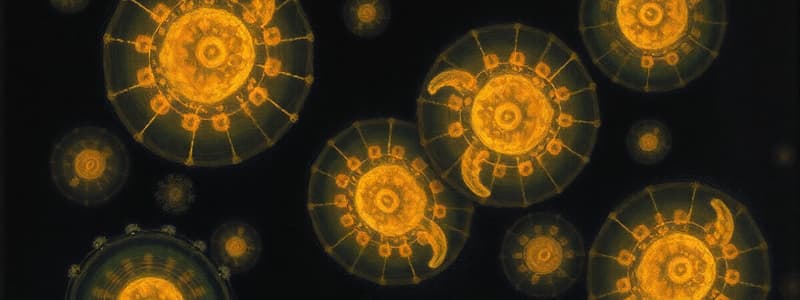Podcast
Questions and Answers
Who was the first person to name the tiny compartments 'cells' after viewing a slice of cork?
Who was the first person to name the tiny compartments 'cells' after viewing a slice of cork?
- Robert Hooke (correct)
- Virchow
- Anton van Leeuwenhoek
- Schleiden
Which statement accurately represents a characteristic of prokaryotic cells?
Which statement accurately represents a characteristic of prokaryotic cells?
- They are larger than eukaryotic cells.
- They contain membrane-bound organelles.
- They are typically unicellular. (correct)
- They have a nucleus.
Which of the following is not a part of the cell theory?
Which of the following is not a part of the cell theory?
- New cells are produced from existing cells.
- All living things are composed of cells.
- All cells have the same function. (correct)
- Cells are the basic unit of structure and function in living things.
What is a defining feature of eukaryotic cells compared to prokaryotic cells?
What is a defining feature of eukaryotic cells compared to prokaryotic cells?
What did Schwann conclude regarding cell composition in the 19th century?
What did Schwann conclude regarding cell composition in the 19th century?
What type of reproduction is generally associated with prokaryotic cells?
What type of reproduction is generally associated with prokaryotic cells?
Which of these cell structures is found in both prokaryotic and eukaryotic cells?
Which of these cell structures is found in both prokaryotic and eukaryotic cells?
Which of the following statements is true regarding eukaryotic cells?
Which of the following statements is true regarding eukaryotic cells?
Flashcards are hidden until you start studying
Study Notes
The History of Cell Theory
- Robert Hooke in 1665 first used the term "cell" to describe the small compartments he saw in a thin slice of cork. He used a compound microscope.
- Anton van Leeuwenhoek in 1674 built his own microscopes and was the first to observe living organisms like bacteria under a microscope.
- Schleiden in 1839 concluded that all plants are made of cells.
- Schwann in 1836 came to the conclusion that all animals are made of cells.
- Virchow in 1855 concluded that all cells come from pre-existing cells.
Cell Theory
- All living things are made of cells.
- Cells are the basic unit of structure and function in living things. This means that cells are the smallest unit of life that can carry out all the processes necessary for life.
- New cells are produced from existing cells.
Cell Types
- Prokaryotic cells are simpler cells and are single-celled organisms.
- Eukaryotic cells are more complex, have a nucleus that houses their DNA, and can be single-celled or multicellular.
Prokaryotic Cells
- The name comes from "pro" meaning before and "kary" meaning nucleus.
- These cells don't have a nucleus, their DNA is free-floating in the cytoplasm.
- Examples of prokaryotic cells are bacteria.
- They are smaller than eukaryotic cells.
- Prokaryotic cells have only one membrane: the cell membrane.
- They do not have other membrane-bound organelles, like mitochondria or endoplasmic reticulum.
Eukaryotic Cells
- The name comes from "eu" meaning true and "kary" meaning nucleus.
- They are much larger than prokaryotic cells.
- They have a nucleus that houses their DNA.
- Eukaryotic cells include protists, fungi, plants, and animals.
- Eukaryotic cells contain many membrane-bound organelles.
All Cells Have
- Cell membrane This is the outer layer that surrounds the cell and helps to regulate what enters and exits the cell.
- Cytoplasm This is the gel-like substance that fills the cell and contains all the organelles.
- DNA This is the genetic material of the cell and contains the instructions for making proteins.
Prokaryotes vs. Eukaryotes
- Prokaryotes lack a nucleus and have free-floating DNA. They also lack membrane bound organelles.
- Eukaryotes have a nucleus that encloses their DNA and have membrane-bound organelles.
- Prokaryotes are typically bacteria, while eukaryotes include all other organisms except bacteria.
- Prokaryotes are smaller than eukaryotic cells.
- Prokaryotes are single-celled organisms.
- Eukaryotes can be either single-celled or multicellular.
- Prokaryotes have the simplest cell structure, they are typically only capable of asexual reproduction.
- Eukaryotic cells are more complex and are capable of both asexual and sexual reproduction.
Studying That Suits You
Use AI to generate personalized quizzes and flashcards to suit your learning preferences.




